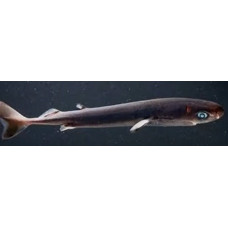Latin name
Euprotomicrus bispinatus
Other names
Requin pygmée (французкий), Pygmäenhai (немецкий), Dwerghaai (голландский).
Identification
The generic name comes from the ancient Greek words εὖ 'good', πρώτος 'first' and μικρός 'small'.
The body shape is elongated and cylindrical, with a small dorsal fin closer to the back of the body. This streamlined body shape allows it to move quickly and efficiently through the water, even in cold and highly pressurised deep water.
The pygmy shark has an elongated body with a rounded, convex snout and large, round eyes. There are sprinkler behind the eyes. The snout is about 2/5 the length of the head, but shorter than the distance from the mouth to the base of the pectoral fins. The gill slits are very small. The nostrils are framed by short leathery flaps that do not form antennae. The lips are thin, without a fringe.
The upper and lower teeth are very different. The upper teeth are smaller than the lower teeth. They have a narrow tip and the edges are smooth. The lower teeth are blade-like, interlocked and the edges are smooth. There are 29 teeth on the upper jaw and 34 teeth on the lower jaw. The upper needle-like teeth are smaller than the lower ones, and the lower teeth are triangular. Their bases are interlocked to form a continuous cutting surface.
The thick lips are fringed and are not adapted for sucking. There are 5 pairs of long gill slits, increasing in size from the first to the fifth pair. There are no spines at the base of the dorsal fins. The precaudal notch and the keel running down the centre of the abdomen are absent. There are lateral carinae. The body is covered with flat placoid scales with smooth margins.
Features of fish fins
The first dorsal fin is tiny and much smaller than the second. Its base is in front of the base of the pelvic fins. The length of the base of the second dorsal fin is 4 times the length of the base of the first. The pectoral fins are rounded. The anal fin is absent. Caudal fin almost symmetrical, both lobes broad and rounded.
Fish colouring
The colouring is almost black, the fins have a noticeable bright edge. The belly is bright.
Distribution
They live in temperate and tropical waters all over the world. In the south central Atlantic, they are found off Ascension Island, east of Fernando de Noronha Island (Brazil) and in the western Cape of Good Hope. In the southern Indian Ocean, they are found from Madagascar to Western Australia. In the South Central Pacific, sharks are found between New Zealand, the Phoenix Islands and the coast of Chile. In the north central and eastern Pacific, they are found from the Midway Islands and Hawaii to the coastal waters of California (USA).
Habitat
Mesopelagic and epipelagic. Mainly found in oceanic habitats in deep waters where the water is usually dark and cold. Unlike most shark species that live in shallow waters, this tiny predator prefers the cooler and darker environment of depths between 200 and 5,000 metres.
Size
Length reaches about 10 inches (25 cm) in females and 8.7 inches (22 cm) in males. The maximum recorded length is 27 cm.
Behavior
In the open ocean they sink to depths of between 1829 and 9938 metres. They can rise to the surface at night and sink into the water column during the day. During daily migrations they can travel over 1500 metres in one direction. They are carnivorous predators.
Food and feeding habits
Their diet consists of bony fish, deep-sea squid and crustaceans.
Reproduction
They reproduce by oviparity, with a litter of up to 8 young about 6 cm long. Males reach sexual maturity at 17-19 cm and females at 22-23 cm.
Fishing
Virtually never caught in nets due to small size and specific habitat.
Human interaction
Not harmful to humans. Non poison.
| Classification | |
| Phylum | Chordata |
| Class | Chondrichthyes |
| Squad | Squaliformes |
| Family | Dalatiidae |
| Genus | Euprotomicrus |
| Species | E. bispinatus |
| Features | |
| Conservation status | Least Concern |
| Habitat | Pelagic |
| Life span, years | No information |
| Maximum body weight, kg | No information |
| Maximum length, cm | 27 |
| Sailing speed, m/s | No information |
| Threat to people | Edible |
| Way of eating | Predator |
Pygmy Shark
Tags: pygmy shark

